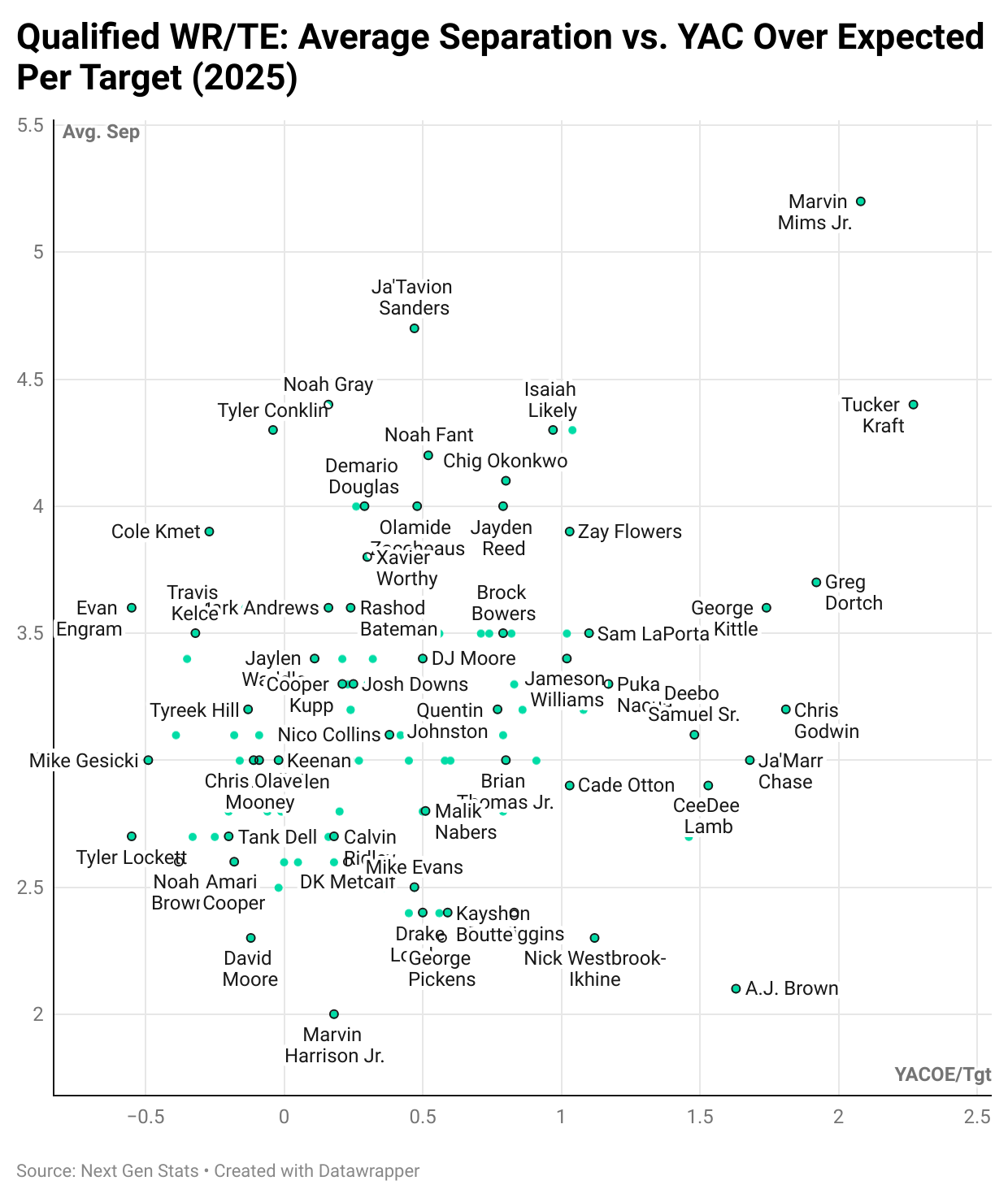Corbin Young provides key fantasy football updates for WRs and TEs from the 2024 season, using Next Gen data to help fantasy owners make the best lineup and waiver wire decisions.
Last season, we covered Next Gen Stats for receivers and tight ends. It's fun to look at different advanced stats after the previous season's digests. There's no rest because many of us dive into the 2025 prospect class leading to the NFL Draft.
We're using a mixture of the publicly available Next Gen Stats and the ones via NFL+. For this installment of the article covering WR/TE, we'll look at Average Separation, Tight Window Percentage, and Catch Rate Over Expected. We also mixed Yards After the Catch Over Expected (YACOE) into the analysis because context matters and it relates to the other metrics.
After defining the metrics, we'll look at the leaders and notable players to highlight. With all the advanced stats, we should wonder which metrics correlate to another. Based on the Next Gen Stats sample, the metric with the second-highest correlation (0.56) involves Expected Points Added (EPA) per Target (Tgt) to yards per route run (YPRR). Unsurprisingly, when we (simply) compared targets per route run (TPRR) to YPRR, it correlates highly (0.73). File that away when we're latching onto advanced metrics for fantasy purposes.
Be sure to check all of our fantasy football rankings for 2025:- 2025 fantasy football rankings (redraft)
- Dynasty fantasy football rankings
- 2025 NFL rookie fantasy football rankings
- Best ball fantasy football rankings
- Quarterback fantasy football rankings
- Running back fantasy football rankings
- Wide receiver fantasy football rankings
- Tight end fantasy football rankings
Average Separation
Next Gen Stats defines average separation as the yards between a wide receiver or tight end and the closest defender at the catch or incompletion. So, it's the yardage distance between the pass-catcher and the defender when the player attempts to make the reception.
All stats need context, though we want receivers who can separate against defenders. That's mainly because when a receiver separates, it theoretically makes it easier to convert receptions. The league average in separation was 3.6 yards.
We had 17 qualified receivers and tight ends with Average Separation metrics higher than the league average. This metric might be noisy because we have several fantasy-relevant names with players who tend to be unreliable. Marvin Mims Jr., Tucker Kraft, Khalil Shakir, Jayden Reed, Zay Flowers, Xavier Worthy, and George Kittle stood out among the 17 pass-catchers with above-average separation yards.
When we look at the top pass-catchers in Average Separation, it's intriguing to consider the yards after the catch over expected per target (YACOE/Tgt). YACOE measures the difference between a player's receiving yards after the catch and the expected YAC. That can show how a player creates explosive plays based on their receptions.
Mims, Kraft, Shakir, Isaiah Likely, Reed, Flowers, Kittle, and Chig Okonkwo had above-average YACOE/Tgt among the leaders sorted by Average Separation. Unsurprisingly, they tend to be the players who produce efficiently, evidenced by their yards per route run.
Mims saw a 29.3 percent target rate on screens and passes with an average target depth of nine yards or lower. For context, Mims boasted a 74 percent targets per route rate with screens and short-area targets. That's notable because Mims should have more average separation yards per target with the role.
We could argue a similar narrative with most tight ends like Kraft, Likely, and Kittle. However, Likely saw an above-average air yards per target rate. The other two receivers with higher air yards per target and above-average numbers in YACOE/Tgt and Average Separation include Flowers and Reed. Flowers and Reed might be players to buy in the offseason.
Way down in the bottom left, we have Marvin Harrison Jr., who had the lowest average separation yards, though that's not too alarming when we have an elite receiver like A.J. Brown next to him. The difference between Harrison and Brown involves their efficiency and ability to create yards after the catch.
Tight Window Percentage
Next Gen Stats defines tight windows as targets when the separation between the receiver and the nearest defender is one yard or fewer. This seems similar to contested targets or contested target rates. The league average for tight window target rates was 14.7 percent.
Among qualified pass-catchers with the highest tight window target rate, we had 19 players finish 10 percentage points above the league average. The most notable include Marvin Harrison Jr., Terry McLaurin, Kyle Pitts, A.J. Brown, Tee Higgins, George Pickens, Drake London, and DK Metcalf.
Context matters, and let's look at these players paired with average separation numbers. It shows mixed results, with Jalen Tolbert, Pitts, McLaurin, and others having high average separation numbers yet higher tight window target rates. That likely tells us these pass-catchers can create separation while having opposing defenses play tight coverage against them when targeted.
Unfortunately, we don't have the average separation on tight-window throws via Next Gen Stats since that would provide further context. However, among the notable pass-catchers with high tight window target rates, Metcalf (2.49) and London (2.37) averaged over 2.00 yards per route run, with McLaurin (1.95) close behind, per Fantasy Points Data.
Our gut tells us to trust the talented receivers in tight windows, including the contested target king as a prospect in Rome Odunze, who averaged 3.0 separation yards and a 20.8 percent tight window target rate. Odunze garnered a 1.91 yards per route run against tight coverage, via the Fantasy Points Data charting. That might present a buying opportunity for Odunze in dynasty leagues.
Catch Rate Over Expected (CROE)
Admittedly, I'm a sucker for these over-expected metrics because it can help us find edges that go beyond the basic stats. Catch Rate Over Expected (CROE) incorporates Expected Points Added (EPA) to calculate the pass-catcher's value in turning their yards into points scored.
The league average for CROE looks awful at 0.012 because we have players with negative catch rates over expected, skewing the data. We have several tight ends with a higher CROE, including Kittle, Mark Andrews, Cole Kmet, Pat Freiermuth, Dallas Goedert, and Mike Gesicki.
Besides the tight ends, we have efficient receivers like Amon-Ra St. Brown, McLaurin, DeVonta Smith, and Brown. That's evident in the yards per route run and EPA/Target for St. Brown, McLaurin, Smith, and Brown.
Chris Olave, Stefon Diggs, and Devaughn Vele stood out as receivers with a high-end CROE. Olave and Diggs earned targets at a higher per-route rate while being relatively efficient. Diggs signed a three-year, $69 million deal with the Patriots on March 25, with $26 million guaranteed. The Patriots have been looking for a WR1 to pair with Drake Maye, but it would benefit them to build depth via the NFL Draft.
Since CROE incorporates EPA, it's logical to bucket this metric as an efficiency metric, similar to using expected fantasy points versus the actual outcomes. Like many of the Next Gen Stats, we expect talented players to earn volume and produce efficiently more often.
Download Our Free News & Alerts Mobile App
Like what you see? Download our updated fantasy football app for iPhone and Android with 24x7 player news, injury alerts, rankings, starts/sits & more. All free!

More Fantasy Football Analysis





 RADIO
RADIO




























